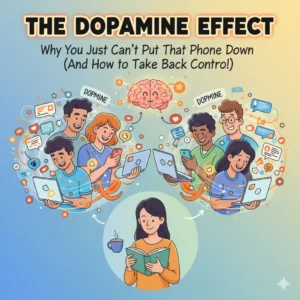The Dopamine Effect – Why You Just Can’t Put That Phone Down (And How to Take Back Control!)

Smartphones have turned into a lifeline for communication, entertainment, and productivity. Yet, more people admit to checking their devices almost every few minutes—often without intention. This isn’t just a habit but a brain-driven cycle powered primarily by a chemical called dopamine. Understanding this mechanism can help you recognize why it’s so hard to put your phone down and, more importantly, how to regain control of your attention and time.
What Is Dopamine and Why It Matters
Dopamine is a neurotransmitter in the brain that plays a key role in motivation, reward, and learning. It doesn’t just make you feel pleasure—it drives you to seek out experiences that might feel rewarding. Every notification ping, new like, or fresh scroll of content offers a potential tiny “reward,” which stimulates dopamine release and reinforces the habit loop.
In other words, every time your phone buzzes, your brain anticipates something exciting—a message, a compliment, or breaking news—and dopamine pushes you to check immediately. Over time, this cycle strengthens, making phone use less a conscious choice and more an automatic behavior.
How Apps Hack the Dopamine Loop
Major social media platforms are designed around exploiting the dopamine cycle. Features such as infinite scroll, push notifications, streaks, and algorithms maximize unpredictable rewards. This unpredictability makes phone engagement addictive. Think about it: you don’t always find amazing content when scrolling, but occasionally you do—and that variable reward makes your brain crave the next hit.
Some examples include:
Infinite scrolling: No natural stopping points keep your brain hooked.
Likes and comments:Social feedback validates our need for connection and belonging.
Notifications: Red dots and alerts create urgency and FOMO (fear of missing out).
Personalized feeds: Algorithms tailor content that you’re most likely to engage with, fueling deeper sessions.
Each of these design choices doesn’t merely entertain—it conditions your brain into staying attached to the device.
Why This Matters for Mental Health and Productivity
While dopamine-driven phone use gives short-term rewards, it often leads to long-term downsides:
Reduced attention span and focus, especially during work or study.
Increased anxiety and stress from constant notifications.
Poor sleep quality when devices are used late at night.
Less face-to-face social interaction and deeper feelings of isolation.
The danger isn’t the existence of dopamine—it’s the imbalance. Your brain gets trained to seek quick, superficial rewards instead of deeper, more fulfilling ones like pursuing hobbies, exercising, or meaningful conversation.
Taking Back Control: Practical Strategies
The good news? You can retrain your brain and regain control. Here are some effective strategies:
Turn off non-essential notifications:Only allow what’s truly important (calls, messages). This reduces constant dopamine-triggering interruptions.
Create phone-free zones:Keep devices out of the bedroom during sleep or away from the dining table to build healthier boundaries.
Use intentional app limits: Tools like Screen Time (iOS) or Digital Wellbeing (Android) help monitor and restrict usage. Commit to only a set amount of social media time daily.
Batch check your phone: Instead of responding instantly, schedule specific times to check emails, messages, or updates.
Embrace boredom: Don’t instantly reach for your device in idle moments. Allow your mind to wander—it often sparks creativity and better reflection.
Replace with rewarding alternatives: Fill downtime with more fulfilling activities like reading, exercise, or journaling to reprogram dopamine release toward healthier habits.
Reframing Phone Use
The goal isn’t to abandon your phone. It’s recognizing that your attention and mental energy are valuable resources that shouldn’t be dictated solely by app design. Approach your device intentionally: use it to enhance your life, connect meaningfully, and learn—but set limits that protect your focus and well-being.
When you understand that an endless scroll isn’t just fun but a dopamine-driven cycle, it’s easier to say “pause” and reflect before you swipe. Small, consistent changes in habits can override those compulsive pulls and return balance to your digital life.
Final Thought
The dopamine effect explains why our phones feel almost irresistible. But once you see that it’s not “lack of willpower” but a biological loop being hijacked, you can take conscious steps to reset the system. Control doesn’t come from rejecting technology—it comes from mastering its role in your life. By setting boundaries and directing dopamine toward healthier rewards, you regain not just your time but also your clarity, focus, and peace.
To read more of my content, please check out my webpage: https://haseema.com